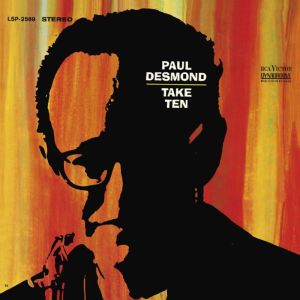Living Stereo Titles Available Now
200+ Reviews of Living Stereo Records
- Paul Desmond’s 1963 Cool Jazz Classic arrives with Shootout Winning Triple Plus (A+++) sound on side one, mated with an outstanding Double Plus (A++) side two
- The brilliant Ray Hall engineered – anyone hearing this copy will understand exactly why we love to find his fabulous ’60s recordings here at Better Records
- Desmond joins forces here with Jim Hall, whose guitar stylings perfectly complement Paul’s velvety sax tone
- 4 1/2 stars: “Everyone wanted Desmond to come up with a sequel to the monster hit “Take Five”; and so he did, reworking the tune and playfully designating the meter as 10/8. Hence “Take Ten,” a worthy sequel… There is not a single track here that isn’t loaded with ingeniously worked out, always melodic ideas.”
For us audiophiles both the sound and the music here are enchanting. If you’re looking to demonstrate just how good 1963 All Tube Analog sound can be, this killer copy will do the trick.
This vintage pressing is spacious, sweet and positively dripping with ambience. Talk about Tubey Magic, the liquidity of the sound here is positively uncanny. This is vintage analog at its best, so full-bodied and relaxed you’ll wonder how it ever came to be that anyone seriously contemplated trying to improve it.
This IS the sound of Tubey Magic. No recordings will ever be made like this again, and no CD will ever capture what is in the grooves of this record. There may well be a CD of this album, but those of us in possession of a working turntable and a good collection of vintage vinyl could care less.
An Overlooked Classic of Cool Jazz
What the best sides of this album have to offer is clear for all to hear:
- The biggest, most immediate staging in the largest acoustic space
- The most Tubey Magic, without which you have almost nothing. CDs give you clean and clear. Only the best vintage vinyl domestic pressings like this one offer the kind of Tubey Magic that was on the tapes in 1963
- Tight, note-like, rich, full-bodied bass, with the correct amount of weight down low
- Natural tonality in the midrange — with all the keyboards, guitars and drums having the correct sound for this kind of recording
- Transparency and resolution, critical to hearing into the three-dimensional space of the studio
No doubt there’s more but we hope that should do for now
Playing the record is the only way to hear all of the above, and playing the best pressings against a pile of other copies under rigorously controlled conditions is the only way to find a pressing that sounds as good as this one does.
The Players and Personnel
Alto Saxophone – Paul Desmond
Bass – Gene Wright (tracks: A1), Gene Cherico (tracks: A2-B4)
Drums – Connie Kay
Guitar – Jim Hall
Engineer – Ray Hall
Producer – George Avakian
Best Practices
If you have five or ten copies of a record and play them over and over against each other, the process itself teaches you what’s right and what’s wrong with the sound of the album. Once your ears are completely tuned to what the best pressings do well that the others do not do as well, using a few specific passages of music, it will quickly become obvious how well any given pressing reproduces those passages.
The process is simple enough. First, you go deep into the sound. There you find something special, something you can’t find on most copies. Now, with the hard-won knowledge of precisely what to listen for, you are perfectly positioned to critique any and all pressings that come your way.
TRACK LISTING
Side One
Take Ten
El Prince
Alone Together
Embarcardero
Side Two
Theme From “Black Orpheus”
Nancy
Samba De Orfeu
The One I Love (Belongs To Somebody Else)
AMG 4 1/2 Star Review
Now listeners enter the heart of the Paul Desmond/Jim Hall sessions, a great quartet date with Gene Cherico manning the bass (Gene Wright deputizes on the title track) and MJQ drummer Connie Kay displaying other sides of his personality.
Everyone wanted Desmond to come up with a sequel to the monster hit “Take Five”; and so he did, reworking the tune and playfully designating the meter as 10/8. Hence “Take Ten,” a worthy sequel with a solo that has a Middle-Eastern feeling akin to Desmond’s famous extemporaneous excursion with Brubeck in “Le Souk” back in 1954. It was here that Desmond also unveiled a spin-off of the then-red-hot bossa nova groove that he called “bossa antigua” (a sardonic play-on-words meaning “old thing”), which laid the ground for Desmond’s next album and a few more later in the decade.
Two of the best examples are his own tunes, the samba-like “El Prince” (named after arranger Bob Prince), an infectious number with on-the-wing solo flights that you can’t get out of your head, and the haunting “Embarcadero.” Hall now gets plenty of room to stretch out, supported by Kay’s gently dropped bombs, and he is the perfect understated swinging foil for the wistful altoist. There is not a single track here that isn’t loaded with ingeniously worked out, always melodic ideas.
